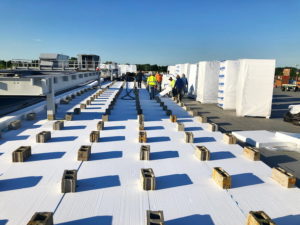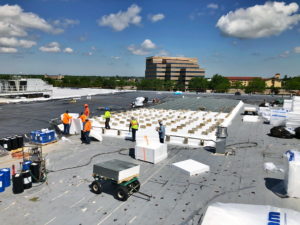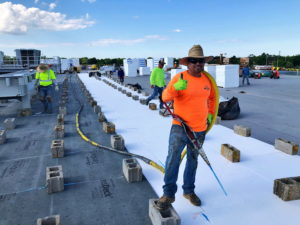Near O’Hare International Airport, IL: Customized EPS Products from Insulfoam Gives Network Operation Center its Wings

Dubbed the nation’s busiest airport in terms of total flights, Chicago O’Hare International Airport accommodated 83 million passengers and 900,000 arriving and departing flights in 2019. Unsurprisingly, nearly every domestic commercial airline carrier is represented at the international transportation hub. To ensure passengers arrive to their final destination safely and on time, each airline company is supported by a network operation center (NOC). From this offsite locale, hundreds of highly trained employees coordinate logistics and monitor day-to-day flight activity.
When it comes to creating a best-in-class NOC facility, a well-insulated roofing system can play an integral role in optimizing operating efficiencies. So, when a major commercial airline carrier purchased a 200,000 square foot warehouse space near O’Hare to house its new NOC, project architects turned their attention to the roof. Upon further examination, the existing roof system was deemed subpar and the design team elected for a complete overhaul.
Challenged with sourcing a superior insulation material for the renovation, the project’s roofing company opted for tapered and flat expanded polystyrene (EPS) from Insulfoam. Well-suited for most roofing applications, EPS’ ability to achieve a high R-value with fewer layers of material would meet the project’s overall cost-savings goals and bottom line.

Designing improved drainage methods was also a top priority for the project, and EPS helped the design team meet this goal. While today’s roofing construction practices typically call for a positive slope that allows water to run off, these structures can be costly and labor intensive to create. Tapered EPS insulation simplifies the build-up process and addresses the project team’s need to optimize material and labor costs.
“Generally, employing tapered solutions within a roofing system is pretty costly,” said Kris Eschmeyer, Territory Sales Manager, Insulfoam. “However, Insulfoam’s tapered EPS is available in sizeable blocks up to 40 inches thick and can be customized to satisfy virtually any slope. In this circumstance, Insulfoam helped meet the desired R-value without the added material or labor costs that are typically associated with building up multiple layers of insulation on the roof.”
Armed with tapered EPS, the project design team easily built up a 0.25-inch slope atop the NOC roof deck in an economical fashion. In total, the factory-cut, customized blocks of tapered EPS called for less material handling and could be installed quickly due to their lightweight nature. This aided in accelerating the projects’ timeline and keeping the budget out of the red.
“In addition to supplying tapered EPS options, Insulfoam also equipped the NOC design team with EPS valley panels,” adds Eschmeyer. “Often with new sloped roofing systems, professionals have to cut every valley in half diagonally and throw the unused piece away. In contrast, our pre-cut valley panels were tailored to meet specific project needs before they arrived on site. This customization dramatically reduced product waste and eliminated the need for the crew to custom cut panels on the jobsite.”

Not only does EPS support material and labor cost-savings, but it also provides an impressively high R-value for greater insulating effectiveness. Much to the delight of project architects, Insulfoam was able to achieve the desired R-25 designation in just three layers of high density insulation. Further, because there is no off-gassing from EPS, the R-value of the roof will remain stable over its entire service life.
The first-rate thermal performance and large size of EPS roof panels perform efficiently in application; by reducing the number of breaks in the roof system that can lead to thermal bridging, less energy is required to heat or cool the NOC. As a result, the warehouse space will stay cooler in Chicago’s humid summer months and retain warmth in the frigid fall and winter seasons. After two years of construction, the NOC renovation was completed in July of 2020. Covered by high-performing tapered, flat and custom valley panel blocks of EPS, the NOC will surely support airline communication and ensure the safety of passengers in the sky for years to come.

